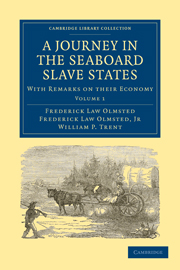CHAPTER II - VIRGINIA
Published online by Cambridge University Press: 29 August 2010
Summary
Dec. 16th. From Washington to Richmond, Virginia, by the regular great southern route—steamboat on the Potomac to Acquia Creek, and thence direct by rail. The boat makes 55 miles in 33½ hours, including two stoppages (12½ miles an hour); fare $2 (3.6 cents a mile). Flat rail; distance, 75 miles; time, 5½ hours (13 miles an hour); fare, $3.50 (4⅔ cents a mile).
Not more than a third of the country, visible on this route, I should say, is cleared; the rest is mainly a pine forest. Of the cleared land, not more than one-quarter seems to have been lately in cultivation; the rest is grown over with briars and bushes, and a long, coarse grass of no value. But two crops seem to be grown upon the cultivated land—maize and wheat. The last is frequently sown in narrow beds and carefully surfacedrained, and is looking remarkably well.
A good many substantial old plantation mansions are to be seen; generally standing in a grove of white oaks, upon some hill-top. Most of them are constructed of wood, of two stories, painted white, and have, perhaps, a dozen rude-looking little log-cabins scattered around them, for the slaves. Now and then, there is one of more pretension, with a large porch or gallery in front, like that of Mount Vernon. These are generally in a heavy, compact style; less often, perhaps, than similar establishments at the North, in markedly bad, or vulgar taste; but seldom elegant, or even neat, and almost always in sad need of repairs.
- Type
- Chapter
- Information
- A Journey in the Seaboard Slave StatesWith Remarks on their Economy, pp. 18 - 182Publisher: Cambridge University PressPrint publication year: 2009First published in: 1856

